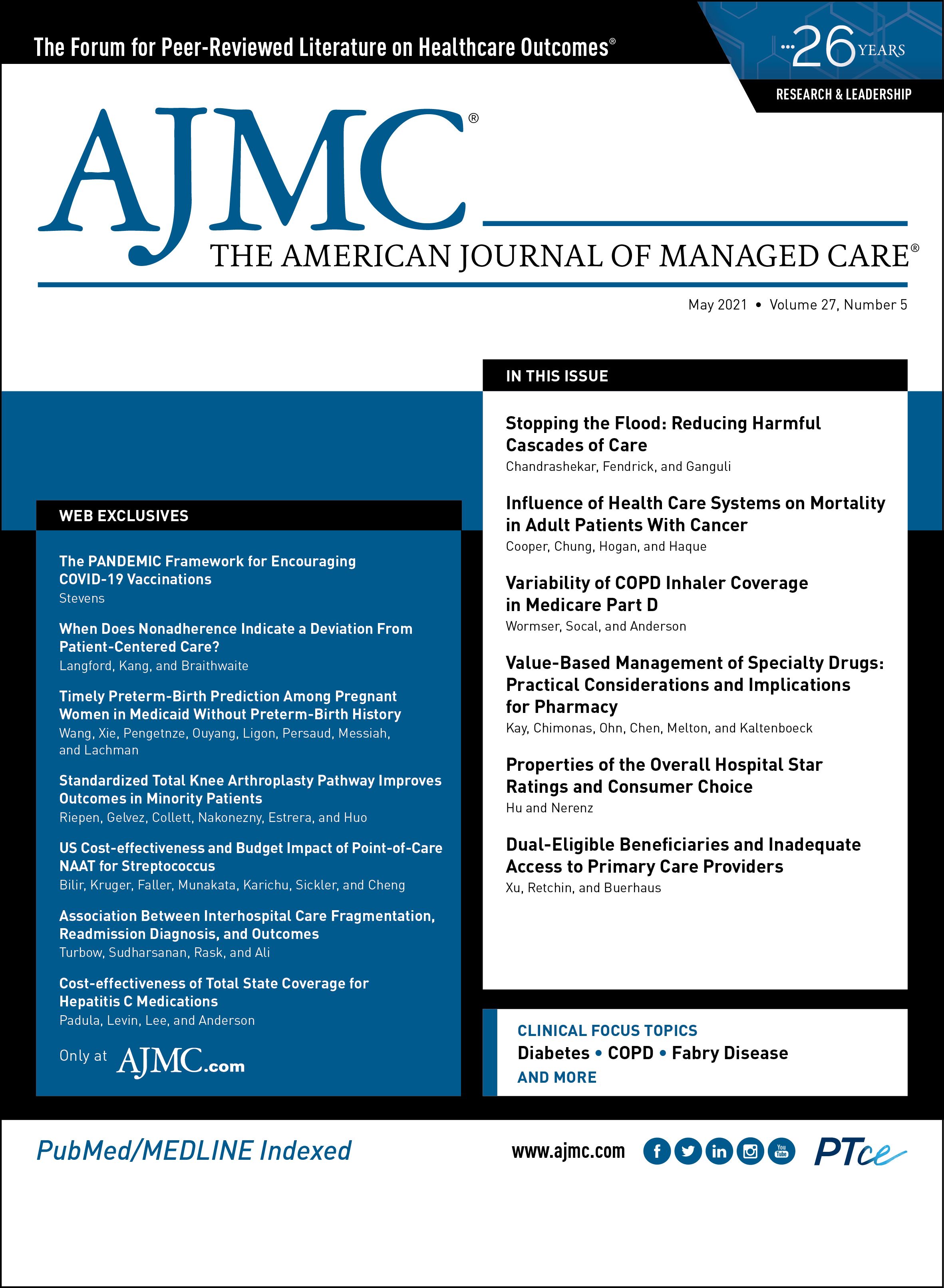Publication
Article
The American Journal of Managed Care
Influence of Health Care Systems on Mortality in Adult Patients With Cancer
Author(s):
Vertically integrated health care delivery systems may be well positioned to help reduce overall mortality and specifically mitigate racial/ethnic disparity gaps in cancer care outcomes.
ABSTRACT
Objectives: We compared all-cause mortality in insured patients with cancer who were diagnosed in Kaiser Permanente Southern California (KPSC), the largest integrated health care delivery system in southern California, with that in patients diagnosed in hospitals that serve other private insurance (OPI) plans.
Study Design: Retrospective cohort study.
Methods: Using the California Cancer Registry, we conducted a cohort analysis of all insured adults diagnosed between 2009 and 2014 with 8 common cancers (breast, prostate, lung, colon, melanoma, endometrium, kidney, and bladder) and followed them through December 2017. The cohort comprised 164,197 patients with cancer. We calculated person-year mortality rates by health care system (KPSC and OPI), and we estimated adjusted HRs for the association between overall mortality and health care system using Cox proportional hazards models accounting for race/ethnicity, demographics, cancer site, tumor characteristics, payer, cancer treatments, and socioeconomic status.
Results: We observed 41,727 deaths during the 9 years of follow-up. We found that the patients diagnosed in KPSC had lower overall mortality rates than in the OPI group, a difference that also held within each age category, racial/ethnic group, and stage at diagnosis. In multivariable models adjusting for relevant covariates, African American/Black patients (adjusted HR, 1.14; 95% CI, 1.06-1.21) and Hispanic patients (adjusted HR, 1.23; 95% CI, 1.16-1.30) in the OPI group had dramatically higher mortality risks than those diagnosed in KPSC.
Conclusions: Among insured patients with cancer in southern California, those diagnosed within KPSC had lower overall mortality compared with the OPI group. Furthermore, this protective effect was greatest for African American/Black patients and Hispanic patients.
Am J Manag Care. 2021;27(5):182-185. https://doi.org/10.37765/ajmc.2021.88631
Takeaway Points
- In this large population registry–based study of 164,197 insured patients, we determined that the overall mortality rates among patients with cancer in Kaiser Permanente Southern California, a large vertically integrated health care delivery system, were lower than those among patients cared for in other private settings, especially for African American/Black patients and Hispanic patients.
- Data suggest that vertically integrated health care delivery systems may be well positioned to help reduce disparity gaps in cancer outcomes.
Inadequate health insurance coverage is a major contributor to disparities in cancer outcomes.1-5 Other potential factors include tumor biology differences, health literacy, difficulties navigating the health care system, and providers’ implicit bias.6-8 Optimal cancer care is complex, but integrated health care systems may provide advantages by facilitating care coordination among providers compared with other systems of care. For example, the Veterans Affairs health care system, an integrated health care system (IHS), has mitigated some of the racial/ethnic health disparities in its population.9 A study reported that patients treated in a National Cancer Institute Comprehensive Cancer Center (NCICCC) had better overall survival compared with those who received care in the community.10 However, that study also noted that less than 6% of patients in Los Angeles County receive care at NCICCCs and that this population includes fewer minorities and more affluent patients.10 Thus, we aimed to examine overall survival of insured patients diagnosed with cancer within the largest vertically integrated health care system in southern California, Kaiser Permanente Southern California (KPSC), compared with insured patients diagnosed in other hospitals, which included community, academic, and NCICCC hospitals in the same geographic region. We evaluated differences in overall mortality between the 2 patient groups and specifically by race/ethnicity and socioeconomic status (SES) groups.
METHODS
Subjects and Study Design
This retrospective cohort study included all insured adults (≥ 20 years) in southern California diagnosed with 8 common cancers (breast, prostate, lung, colon, melanoma, endometrium, kidney, and bladder) between January 1, 2009, and December 31, 2014, using data from the California Cancer Registry (CCR), and followed through December 31, 2017 (maximum of 9 years). Data were collected from 7 counties: Imperial, Kern, Los Angeles, Orange, Riverside, San Bernardino, and San Diego. Additional inclusion criteria included the cancer being diagnosed at invasive stages (American Joint Committee on Cancer tumor/node/metastasis stages 0-IV) and the patient having health insurance coverage. Health insurance coverage included those with the following: IHS/managed care, preferred provider organization, Medicare, Medicaid, dual coverage (Medicare and Medicaid), and other private insurance. The study was approved by internal review boards (IRBs) of KPSC and the State of California. Each IRB waived the requirement for written or verbal consent due to the deidentified nature of the data.
Independent Variable
We divided our data set of insured patients into (1) those whose cancers were diagnosed in the largest integrated health care delivery system in southern California, KPSC, which provides insurance and health care to approximately 25% of the insured population; and (2) those with other private insurance (OPI) whose cancers were diagnosed at other community, academic, NCICCC, and non-KPSC hospitals. KPSC includes 4.6 million patients, 13 hospitals, more than 200 clinics, and more than 8000 primary and specialty care physicians.
Main Outcomes and Covariates
The main outcome was all-cause (overall) mortality, and subjects were followed through December 31, 2017. Dates of death and all variables were also ascertained from the CCR. A main covariate of interest included race/ethnicity (non-Hispanic White, African American/Black, Hispanic, Asian/Pacific Islander, Native American, other/mixed/unknown) coded according to the North American Association of Central Cancer Registries algorithm.11 Other covariates extracted included age and stage at diagnosis, sex, diagnosis year, anatomic cancer site, primary cancer therapy (surgery), adjuvant therapy (receipt of chemotherapy, radiation therapy, and/or hormonal therapy), health insurance source, SES, and county of residence.
Statistical Analysis
We examined frequencies and percentages of all variables, then calculated person-year (PY) mortality rates (using patients’ time at risk as the denominator) and 95% CIs by health care system. Multivariable adjusted HRs for the association between type of health care system (KPSC or OPI) and overall mortality were estimated using multivariable Cox proportional hazards models. In the Cox models, patients were followed up to date of death or December 31, 2017, whichever occurred first. The proportional hazards assumption was evaluated via Schoenfeld residuals; no significant violation was found. All analyses were performed using SAS version 9.4 (SAS Institute).
RESULTS
A total of 164,197 adults were diagnosed with cancers of the breast, prostate, lung, colon, melanoma, endometrium, kidney, and bladder in southern California between 2009 and 2014. A total of 41,727 deaths occurred during the ensuing 9 follow-up years. About 28.6% of patients were diagnosed at KPSC and 71.4% in the OPI group, reflecting approximately the baseline patient distributions within each group. Table 1 shows the distribution of the patients by demographics and health care system (KPSC or OPI). The KPSC group had more African American patients (13.5% vs 5.5%) and more Hispanic patients (21.9% vs 16.6%) but fewer patients in the highest SES group (19.9% vs 30.2%) compared with the OPI group, respectively.
Of the 8 cancers in the analysis, breast (30.0%) and prostate (20.7%) cancers accounted for half of the cancers diagnosed in the full cohort, but we found a higher percentage of prostate cancer (25.0% vs 18.9%) and a slightly lower percentage of breast (27.4% vs 31.2%) and lung (12.8% vs 15.3%) cancers in KPSC vs the OPI group, respectively. The KPSC group had a slightly higher percentage of patients diagnosed with stage I cancers (41.4% vs 38.3%).
Table 2 shows that the KPSC patients had lower overall mortality rates by cancer stage, age at diagnosis, sex, and race/ethnicity compared with OPI patients. For example, the mortality rates were lower for those with stage III to IV disease in KPSC (271.6 per 1000 PY) vs OPI (284.9 per 1000 PY). Mortality rates for patients 65 years and older were also lower in KPSC (122.4 per 1000 PY vs 139.4 per 1000 PY in the OPI group). For both sexes, the mortality rates were lower in the KPSC group (eg, women: 70.2 per 1000 PY) than in the OPI group (women: 79.2 per 1000 PY). The mortality rates in Table 2 also demonstrate that overall mortality rates were lower in all racial/ethnic groups in KPSC than in the OPI group. Notably, mortality rates were dramatically lower in African American/Black patients (88.5 per 1000 PY vs 108.2 per 1000 PY) and Hispanic patients (52.5 per 1000 PY vs 78.1 per 1000 PY) in KPSC than in the OPI group, respectively.
Table 3 shows the association between overall mortality and health care system by race/ethnicity. In these multivariable models, the adjusted overall mortality risk was statistically significantly higher in African American/Black patients (adjusted HR, 1.14; 95% CI, 1.06-1.21) and Hispanic patients (adjusted HR, 1.23; 95% CI, 1.16-1.29) in the OPI group than in the KPSC group. These models were adjusted for age and stage at diagnosis, sex, year of diagnosis, anatomic cancer site, primary cancer therapy (surgery), adjuvant therapy (receipt of chemotherapy, radiation therapy, and/or hormonal therapy), SES, and county of residence. We could not calculate the HRs for Native Americans and those in the other/mixed/unknown group due to small numbers of deaths.
DISCUSSION
In an insured group of patients, we determined that although KPSC had a higher proportion of minority patients and of patients in the lower SES groups, the overall mortality rates in KPSC were lower than in the OPI group. We also observed markedly lower mortality across all age groups and diagnosis stages in the KPSC cohort. Furthermore, the adjusted mortality risks were significantly higher in African American/Black patients and Hispanic patients in the OPI group compared with KPSC.
In 2013, the Institute of Medicine (IOM) published a framework of an effective cancer care delivery system,12 which leverages an electronic health record, systematic quality measurement with performance improvement, robust safety nets, and use of tumor board review, which can lead to accessible, affordable cancer care. All these components, including access to clinical trials, are present within KPSC, but the present analysis did not have data on quality care metrics to determine which of these factors, if any, contributed to the lower overall mortality rates in the KPSC group compared with the OPI group. It is also possible that the higher fraction of patients diagnosed with stage I cancer (Table 1) may be due to differences resulting from greater access to screening in the KPSC group, which might have contributed to the lower mortality rates for breast cancer and colorectal cancer as shown in Table 2. Moreover, a system such as that described by the IOM would overcome health disparities related to race/ethnicity and SES. The Veterans Affairs health care system embodies many of the systems described in the IOM and has already reported reduced cancer outcomes disparities when adjusted for covariates.9 A study by Rhoads et al showed that the African American/White differences in colorectal cancer survival have been reduced in California and that African American patients actually had better survival than White patients within IHSs like KPSC13; this may be attributed to better care coordination. However, another national study suggested that colorectal cancer screening was lower in non-White patients and that systems seeking to reduce this disparity need to employ targeted approaches to encourage screening across different racial/ethnic groups.14 We suggest that the IOM’s guideline for optimal cancer care delivery, with its emphasis on the benefits of care integration, should serve as a foundation for reducing outcome disparities.
Limitations
Certain study limitations must be considered. There was no review of the hospital where care was delivered after diagnosis. It is possible that some patients diagnosed in KPSC received care in the OPI setting and vice versa. However, in a prior study, we determined that many patients with cancer remained enrolled within the KPSC health plan several years post diagnosis; for example, 80% of women diagnosed with breast cancer stayed within the KPSC health plan 20 years after initial diagnosis.15 There are also possibly covariates outside those considered within this study that could affect outcomes. However, we adjusted for the most traditional covariates known to affect cancer care outcomes. Further, we could not compare cancer incidence between the 2 cohorts because we did not have denominator data for the OPI group; it is possible that the longer postdiagnosis survival in KPSC could have been due to the increased early-stage cancer incidence, given KPSC’s screening programs.
CONCLUSIONS
Our data suggest that KPSC, an example of a vertically integrated health care system, may be well positioned to help reduce overall mortality and specifically mitigate racial/ethnic disparity gaps in cancer care outcomes. Based on our analyses, other private insurers might better serve their insured populations, especially minority patients, by integrating core elements of the KPSC cancer care program into their repertoire. The issue of assessing quality of care, along with the impact of the health care system on outcomes, merits continued study.
Author Affiliations: Department of Pediatric Hematology/Oncology, Southern California Permanente Medical Group, Kaiser Permanente Los Angeles Medical Center (RMC), Los Angeles, CA; Department of Research & Evaluation, Kaiser Permanente Southern California (JC, RH), Los Angeles, CA; Department of Hematology/Oncology, Kaiser Permanente Los Angeles Medical Center (TH), Los Angeles, CA; Department of Health Systems Science, Kaiser Permanente Bernard J. Tyson School of Medicine (RH), Pasadena, CA.
Source of Funding: Kaiser Permanente Southern California.
Author Disclosures: The authors report no relationship or financial interest with any entity that would pose a conflict of interest with the subject matter of this article.
Authorship Information: Concept and design (RMC, RH); acquisition of data (RMC, RH); analysis and interpretation of data (RMC, JC, TH, RH); drafting of the manuscript (RMC, TH, RH); critical revision of the manuscript for important intellectual content (RMC, JC, TH, RH); statistical analysis (JC, RH); provision of patients or study materials (RH); obtaining funding (RMC); administrative, technical, or logistic support (RH); and supervision (RMC).
Address Correspondence to: Reina Haque, PhD, MPH, Kaiser Permanente Southern California, 100 S Los Robles, Pasadena, CA 91101. Email: Reina.Haque@kp.org.
REFERENCES
1. Del Pino S, Sánchez-Montoya SB, Guzmán JM, Mújica OJ, Gómez-Salgado J, Ruiz-Frutos C. Health inequalities amongst people of African descent in the Americas, 2005-2017: a systematic review of the literature. Int J Environ Res Public Health. 2019;16(18):3302. doi:10.3390/ijerph16183302
2. American Cancer Society. Cancer Facts and Figures, 2018. American Cancer Society; 2018.
3. Marlow NM, Pavluck AL, Bian J, Ward EM, Halpern MT. The Relationship Between Insurance Coverage and Cancer Care: A Literature Synthesis. RTI Press; 2009.
4. Halpern MT, Ward EM, Pavluck AL, Schrag NM, Bian J, Chen AY. Association of insurance status and ethnicity with cancer stage at diagnosis for 12 cancer sites: a retrospective analysis. Lancet Oncol. 2008;9(3):222-231. doi:10.1016/S1470-2045(08)70032-9
5. Ward E, Jemal A, Cokkinides V, et al. Cancer disparities by race/ethnicity and socioeconomic status. CA Cancer J Clin. 2004;54(2):78-93. doi:10.3322/canjclin.54.2.78
6. FitzGerald C, Hurst S. Implicit bias in healthcare professionals: a systematic review. BMC Med Ethics. 2017;18(1):19. doi:10.1186/s12910-017-0179-8
7. Fedewa SA, Cokkinides V, Virgo KS, Bandi P, Saslow D, Ward EM. Association of insurance status and age with cervical cancer stage at diagnosis: National Cancer Database, 2000-2007. Am J Public Health. 2012;102(9):1782-1790. doi:10.2105/AJPH.2011.300532
8. Penner LA, Dovidio JF, Gonzalez R, et al. The effects of oncologist implicit racial bias in racially discordant oncology interactions. J Clin Oncol. 2016;34(24):2874-2880. doi:10.1200/JCO.2015.66.3658
9. Zullig LL, Jackson GL, Weinberger M, Provenzale D, Reeve BB, Carpenter WR. An examination of racial differences in process and outcome of colorectal cancer care quality among users of the Veterans Affairs health care system. Clin Colorectal Cancer. 2013;12(4):255-260. doi:10.1016/j.clcc.2013.06.004
10. Wolfson JA, Sun CL, Wyatt LP, Hurria A, Bhatia S. Impact of care at comprehensive cancer centers on outcome: results from a population-based study. Cancer. 2015;121(21):3885-2893. doi:10.1002/cncr.29576
11. Parikh-Patel A, Morris CR, Kizer KW. Disparities in quality of cancer care: the role of health insurance and population demographics. Medicine (Baltimore). 2017;96(50):e9125. doi:10.1097/MD.0000000000009125
12. Institute of Medicine. Delivering High-Quality Cancer Care: Charting a New Course for a System in Crisis. The National Academies Press; 2013.
13. Rhoads KF, Patel MI, Ma Y, Schmidt LA. How do integrated health care systems address racial and ethnic disparities in colon cancer? J Clin Oncol. 2015;33(8):854-860. doi:10.1200/JCO.2014.56.8642
14. Burnett-Hartman AN, Mehta SJ, Zheng Y, et al; PROSPR Consortium. Racial/ethnic disparities in colorectal cancer screening across healthcare systems. Am J Prev Med. 2016;51(4):e107-e115. doi:10.1016/j.amepre.2016.02.025
15. Haque R, Ahmed SA, Inzhakova G, et al. Impact of breast cancer subtypes and treatment on survival: an analysis spanning two decades. Cancer Epidemiol Biomarkers Prev. 2012;21(10):1848-1855. doi:10.1158/1055-9965.EPI-12-0474







